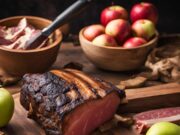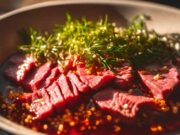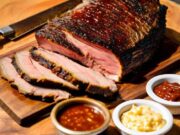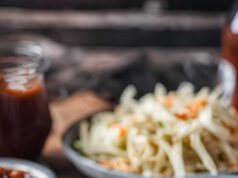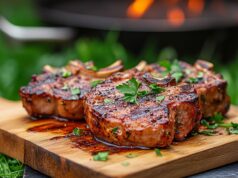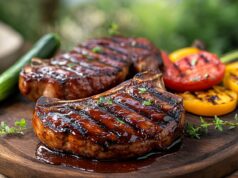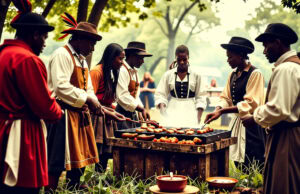Pork souvlaki and barbecue represent two quintessential expressions of culinary tradition and outdoor cooking. While souvlaki holds a special place in Greek cuisine, barbecue is a beloved practice in many cultures worldwide. Both methods highlight the versatility of pork, infusing it with rich flavors through different marinades, cooking techniques, and cultural influences. This article delves into the history, preparation methods, and cultural significance of pork souvlaki and barbecue, celebrating the artistry behind these delicious dishes.
History and Origins
Pork Souvlaki:
Souvlaki, a Greek term meaning “skewer,” dates back to ancient Greece. Historical texts and archaeological finds indicate that skewered meat was a staple in ancient Greek diets, often enjoyed during joyful events and communal gatherings. Pork souvlaki, in particular, became popular due to the availability of pork and the simplicity of the preparation process. Traditionally, small pieces of pork were marinated in a mixture of olive oil, lemon juice, garlic, and herbs, then skewered and grilled over an open flame. This method not only preserved the meat but also enhanced its flavor.
Barbecue:
The practice of barbecuing meat has ancient roots, with variations found in cultures around the globe. The word “barbecue” itself is believed to originate from the Taino people of the Caribbean, who used the term “barbacoa” to describe a method of slow-cooking meat over a wooden platform. European explorers adopted this technique, which spread to North America and evolved into various regional styles. Barbecue became an integral part of American cuisine, particularly in the Southern United States, where pork is a primary ingredient. Each region developed its unique approach, from the vinegar-based sauces of North Carolina to the sweet, tomato-based sauces of Kansas City.
Preparation Techniques
Pork Souvlaki:
The preparation begins with selecting high-quality pork souvlaki, typically from the shoulder or loin. The meat is cut into small, uniform pieces to ensure even cooking. The marinade is crucial in infusing the meat with flavor and tenderizing it. A classic marinade includes olive oil, fresh lemon juice, minced garlic, oregano, salt, and pepper. The pork is left to marinate for several hours or overnight, allowing the flavors to meld. Skewering the meat is an art in itself, with each piece carefully threaded onto wooden or metal skewers. Grilling over medium-high heat ensures that the meat cooks evenly and develops a smoky, charred exterior while remaining juicy inside. Souvlaki is often served with pita bread, tzatziki sauce, fresh vegetables, and lemon wedges.
Barbecue:
Barbecuing pork involves a variety of methods, from slow-cooking whole hogs to smoking ribs and grilling chops. The choice of cut and cooking technique depends on regional preferences and desired flavor profiles. Common cuts for barbecue include pork shoulder (used for pulled pork), ribs, and pork belly. A dry rub, consisting of spices and herbs, is typically applied to the meat before cooking to create a flavorful crust. Ingredients for a dry rub may include paprika, brown sugar, chili powder, garlic powder, and cumin. Barbecue sauces, whether applied during or after cooking, add another layer of complexity. These sauces vary greatly, with some regions favoring tangy vinegar-based sauces and others preferring sweet, molasses-based blends. Slow-cooking at low temperatures is essential for tenderizing the meat and infusing it with a smoky flavor. This is often achieved using smokers or indirect grilling methods. Patience is key, as true barbecue can take several hours to reach perfection.
Cultural Significance
Pork Souvlaki:
In Greece, pork souvlaki is more than just a meal; it is a social experience. It is commonly enjoyed at taverns, street vendors, and home gatherings. The simplicity of souvlaki makes it accessible, while its flavors evoke a sense of tradition and community. Greek festivals and holidays often feature souvlaki as a centerpiece, symbolizing hospitality and celebration. The act of grilling and sharing skewers of meat fosters a sense of camaraderie among friends and family, making souvlaki an integral part of Greek cultural identity.
Barbecue:
Barbecue holds a similarly profound place in various cultures, particularly in the Southern United States. It is often associated with gatherings, from casual backyard cookouts to large-scale events like cook-offs and festivals. Barbecue competitions showcase the skills and creativity of experts, who spend years perfecting their techniques. These events bring together communities, celebrating local traditions and flavors. Barbecue also carries historical significance, reflecting the diverse influences that have shaped American cuisine. From African American contributions in the Deep South to the fusion of Mexican and Texan flavors in Texas barbecue, each style tells a story of cultural exchange and adaptation.
Modern Interpretations
While traditional pork souvlaki remains popular, modern chefs have experimented with new ingredients and techniques to create contemporary twists on the classic dish. Variations might include different marinades, such as those incorporating Asian or Middle Eastern spices, or innovative serving methods, like souvlaki bowls with grains and vegetables. These modern interpretations keep the tradition alive while appealing to diverse palates and dietary preferences.
Barbecue continues to evolve, with chefs and home cooks alike pushing the boundaries of traditional methods. The rise of barbecue fusion has led to the creation of dishes that blend flavors and techniques from different culinary traditions. For example, Korean barbecue pork tacos combine the smoky, savory elements of American barbecue with the bold, spicy flavors of Korean cuisine. Additionally, the focus on sustainability and local sourcing has influenced barbecue practices, with many cooks prioritizing heritage breeds and humane farming practices. These modern approaches to barbecue reflect a growing appreciation for both the art of cooking and the quality of ingredients.
Pork souvlaki and barbecue are more than just cooking methods; they are expressions of cultural heritage and culinary artistry. Both dishes celebrate the rich flavors and versatility of pork, while their preparation and enjoyment foster community and tradition. Whether grilling skewers of marinated pork in a Greek tavern or slow-cooking ribs at a Southern barbecue joint, these practices connect us to our history and to each other. As they continue to evolve, pork souvlaki and barbecue will undoubtedly remain beloved fixtures in the culinary landscape, delighting future generations with their timeless appeal.



